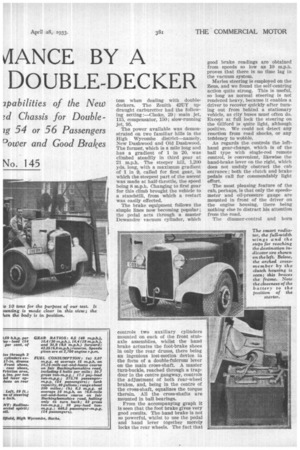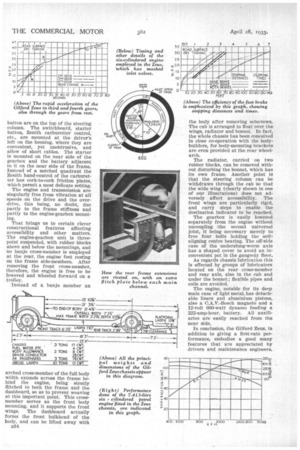FINE PERFOI VIANCE BY A PETROL-ENGINED DOUBLE-DECKER
Page 50

Page 51

Page 52

If you've noticed an error in this article please click here to report it so we can fix it.
THE Gilford Zeus was exhibited at the Scottish Show last November and described in The Commercial Motor dated November 4. At the Show it attracted attention because its design was found to permit the use of, 9.75-in, low-pressure twin rear tyres' within the legal width of 7 ft. 6 ins. These tyres on 22-in. rims (which allow good cooling space around the brake drums) can be fitted to all wheels, the axle ratio being altered to suit, or 9.75-in. by 20-in. tyres can be fitted at the rear with 10.5-in. by 20-in. tyres at the front.
The standard equipment with a 6.5 axle ratio is 9.00-in. by 22-in. rear tyres and 10.50-in. by 20-in. front tyres, and only a few days ago we subjected the chassis, thus equipped and fully laden to 10 tons, to our standard form of road test.
The tyre-size feature is not obtained at the expense of narrowing the frame ; the rear springs are mounted practically under the frame members and, despite the large tyres, a maximum frame width of 3 ft. 54 ins, is obtained. This is more important in a double-deck bus than in any other class of goods or passenger vehicle because of the considerable top weight. Although we could not fully judge the effect on a bare chassis carrying ccincrete blocks, unnaturally severe tests showed the machine to react favourably as regards lateral and general stability, whilst the low-pressure tyres, in conjunction with the reverse-camber springs, afford a comfortable suspension.
• The Gilford Motor Co., Ltd., High Wycombe, is still a supporter of the petrol engine, but it is prepared to equip the Zeus with an oil engine Should the purchaser require it.
The Zeus is easy and pleasant to drive, and reminds one of the 168-OT type, the famous Gilford singledecker chassis which has been such a favourite in the motor coach world. The power is good, an engine of not less than 118 b.h.p. being employed, and the gearbox ratios are so chosen as to permit 30 m.p.h. to be attained in third gear. This is a feature that coach operators have found most useful in keeping up
favourable average speeds on hilly roads without exceeding the legal Speed limit.
For a double-decker 30 m.p.h. is not needed, but the result of the arrangement is a high degree of liveliness around 20 m.p.h. and the avoidance of lost road speed on slight gradients. An examination of the accompanying engine power curves and acceleration graph will explain this.
Full advantage of the useful third gear could not be taken if the gear-change were not easy, but it is— extremely so— rendering the chassis like a car to drive.
The fuel-consumption results in the accompanying panel are selfexplanatory, and are obtained in accordance with our standard sys tern when dealing with doubledeckers. The Zenith 421JY updraught carburetter had the following setting :—Choke, 29; main jet, 115, compensator, 150; slow-running jet, 95.
The power available was demonstrated on two familiar hills in the High Wycombe district—namely, New Dashwood and Old Dashwood. The former, which is a mile long and has a gradient of 1 in 20, was climbed steadily in third gear at 21 m.p.h. The steeper hill, 1,200 yds. long, with a maximum gradient of 1 in 9, called for first gear, in which the steepest part of the ascent was made at half-throttle, the speed being 8 m.p.h. Changing to first gear for this climb brought the vehicle to a standstill, from which a restart was easily effected.
The brake equipment follows the simple lines now becoming popular ; the pedal acts through a master Dewandre vacuum cylinder, which
controls two auxiliary cylinders mounted on each of the front stubaxle assemblies, whilst the hand brake actuates the foot-brake shoes in only the rear drums, there being an ingenious lost-motion device in the form of a double-fulcrum lever on the main cross-shaft. A master turn-buckle, reached through a trapdoor in the centre gangway, controls the adjustment of both rear-wheel brakes, and, being in the centre of the cross-shaft, equalizes the torque therein. All the cross-shafts are mounted in ball bearings.
From the accompanying graph it is seen that the foot brake gives very good results, The hand brake is not so powerful, whilst to use the pedal and hand lever together merely locks the rear wheels. The fact that good brake readings are obtained from speeds so low as 10 m.p.h. proves that there is no time lag in the vacuum system.
Manes steering is employed on the Zeus, and we found the self-centring action quite strong. This is useful, so long as normal steering is not rendered heavy, because it enables a driver to recoVer quickly after turning out from behind a stationary vehicle, as city buses must often do. Except at full lock the steering on the Gilford is quite light, although positive. We could not detect any reaction from road shocks, or any tetidency to wobble.
As regards the controls the lefthand gear-change, which is of the ball type with single-rod remote control, is convenient, likewise the hand-brake lever on the right, which does not unduly obstruct the cab entrance ; both the clutch and brake pedals call for commendably light effort.
The most pleasing feature of the cab, perhaps, is that only the speedometer and oil-pressure gauge are mounted in front of the driver on the engine housing, there being nothing else to distract his attention from the road.
The dimmer-control and horn button are on the top of the steering column. The switchboard, starter button, Zenith carburetter control, etc., are mounted at the driver's left on the housing, where they are convenient, yet unobtrusive, and allow of short cables. The starter is mounted on the near side of the gearbox and the battery adjacent to it on the near side of the frame. Instead of a notched quadrant the Zenith hand-control of the carburetter has cork-to-cork friction plates, which permit a most delicate setting.
The engine and transmission are singularly free from vibration at all speeds on the drive and the overdrive, this being, no doubt, due partly to the frame stiffness and partly to the engine-gearbox mounting.
That brings us to certain clever constructional features affecting accessibility and other matters. The engine-gearbox unit is threepoint suspended, with rubber blocks above and below the mountings, and no banjo cross-member is employed at the rear, the engine feet resting on the frame side-members. After removing the front cross-member, therefore, the engine is free to be lowered and wheeled forward on a trolley.
Instead of a banjo member an arched cross-member of the full body width extends across the frame behind the engine, being stoutly flitched to both the frame and the dashboard, so as to prevent weaving at this important point. This crossmember serves as the front body mounting, and it supports the front wings. The dashboard actually forms the front bulkhead of the body, and can be lifted away with 1334 the body after removing setscrews. The cab is arranged to float over the wings, radiator and bonnet. In fact, the whole chassis has been conceived in close co-operation with the bodybuilders, for body-mounting brackets are even provided at the rear wheelarch.
The radiator, carried on two rubber blocks, can be removed without disturbing the bonnet, which has its own frame. Another point is that the steering column can be withdrawn through the cab so that the wide wing (clearly shown in one of our illustrations) does not adversely affect accessibility. The front wings are particularly rigid, and carry steps to enable the destination indicator to be reached.
The gearbox is easily lowered separately from the engine without uncoupling the second universal joint, it being necessary merely to free four bolts holding the self-I aligning centre bearing. The off-side case of the underslung-worm axle has a shaped cover to avoid an inconvenient pot in the gangway floor.
As regards chassis lubrication this is effected by groups of lubricators located on the rear cross-member and rear axle, also in the cab and under the bonnet ; flexible pipes and coils are avoided.
The engine, notable for its deep main case of light metal, has detachable liners and aluminium pistons, also a C.A.V.-Bosch magneto and a 12-volt 660-watt dynamo feeding a 222-amp-hour. battery. All auxiliaries are easily reached from the near side.
In conclusion, the Gifford Zeus, in addition to giving a first-rate performance, embodies a good many features that are appreciated by drivers and maintenance engineers.




































































































